2018 KTM 350 EXC-F
Middle Of The Road-Road Going Dirt Bike
MSRP: $10,599
- Light, agile, nimble and with power too.
- So close to the race bikes.
- KTM build quality, just do the basics and ride it.
- So complicatedly far from the race bikes.
- Driving right past the $10,000 mark...
Introduction
- KTM's mid-sized dirt bike that is street legal.
KTM takes the EXC-F dual-purpose line very serious. It shows that with the continued development every few years with all-new machines in the EXC line. And it basically takes about a year for the stuff you see in a early release Factory Edition SX model to trickle its way into EXC form. The line has stayed true to some of the proven simplistic traits like the linkageless rear suspension and an open cartridge fork. There is isn't much additional changes from the SX to the EXC aside from stuff that is mandated by road-going regulations to make the bikes complaint, hence some of the things dirt-only riders just get confused by. With the loss of the XC-W off-road-only bikes KTM wanted to make it possible for riders to modify these bikes into four-stroke racers for closed course use if that is the intended purpose, and the EXC can transform if needed.
Changes
- BNG since 2017
- Radiator Guards altered for better airflow in muddy conditions.
- WP Explor settings are stiffer.
The 2018 bike is basically identical to the 2017. The biggest change is to an improved WP front fork with slightly altered outer tubes for less weight with a stiffer setting inside. The shock was altered to match the fork. But from the 2016 the machine is all-new sharing very few parts. The big changes in 2017 were to an all-new engine and frame. Lighter and more compact than the previous EXC and way more refined for passing the emissions and sound regulations. The big changes here was the addition of a reed-valve system located in the air boot before the throttle body and the switch to very road oriented Continental TKC 80 tires. A new fork from WP dubbed the Explor is basically a revision of the open cartridge fork simplifying things with all the adjustment of the compression damping handled on one side and the rebound on the other with adjusters on the top of the fork cap. Similarly the rear shock takes on the shaft and body sizes of the linkage activated shocks but still utilizes the PDS system of dual shock pistons. All of the bodywork is new ans slimmed and flattened just like the race bikes.
Of course the frame is unique due to the rear suspension but it mirrors that of the current linkage-equipped bikes in most ways, Likewise the latest version of the 350cc DOHC short-stroke engine is now smaller and lighter. Kick-start is a thing of the past and there is a plug where a kick lever could reside if you feel the need.
Power
- Very quiet and restricted in stock form--but not anemic.
- Improved torque in lower RPMs from previous 350.
- Less top-end surge than before due to lower rev ceiling.
For a fully street legal emission and sound complaint bike, you have to give KTM credit for getting a 100% rideable package right off the showroom floor. You can take this bike and ride it to your heart's content box stock. You will be greeted with a very quite and surprisingly torquey ride that likes to be ridden in the middle of the power curve but does not complain about being lugged or revved out. It will do it all and do it just fine. If you have not ridden a competition 350cc four-stroke you might not even know the difference. Those more familiar with how much potential there is might be a little disappointed but it did not stop us from riding the bike on our toughest trails and on some long rides before we even felt the need to see how much more there was easily available and how to go about getting it.
Since switching over to fuel injection cleaned up the tailpipe emissions so much, now manufacturers can concentrate on the tougher issue of sound compliance on very compact motorcycles. But FI also got rid of the lean surges and flat spots in the power delivery, reduced stalling by huge margins and helped starting considerably. If you have not ridden a FI four-stroke like the KTM, things have changed in the last few years.
For the majority of this evaluation we left the bike box stock in the engine department. Luckily KTM fitted the bike with real-world usable final-drive gearing unlike in the past. First gear is pretty low so you do not have to re-gear just to go ride some technical trails. Then the ratios spread out in a very linear climb all the way up to a sixth speed that allowed about an 85 MPH top-speed. And if we have one complaint it is that the internal gear ratios seem a little close together in overall spread first to sixth. So close that there seems two gears for any speed. Yet our heavier testers also noted that first was too low and then second was too tall for tight and technical. All of our riders wanted a taller sixth speed since the bike will run into the rev limiter when pinned on flat ground and is spinning a little fast at most highway speeds in top gear. Some of this is because the rev limit has been altered so the bike passes sound tests for on-road. (Don't ask, it's complicated.) We ran with a 50-tooth rear sprocket (down from 52) and for the lighter riders this was the ticket all around. Heavier riders missed the low-low of the stock first gear but now first was more usable for regular slow stuff.
Left stock the biggest issue is the heat that the muffler traps inside and keeps back to the engine when you start running the EXC hard. You can get the cooling fan to kick on and it handles the task but don't touch the muffler! We know from riding some other current EXCs that if you remove the perforated part at the end of the muffler the heat issue is greatly reduced and the sound barely increases to our ears. We also tried an FMF Q4 slip on muffler during our time with the bike and right away the bike picks up some power with the less restrictive muffler but also picks up a noticeable amount of noise. From sewing machine quiet to responsible four-stroke level. To a sound meter it goes from 82 dB to 92 dB (a motocross bike for comparison is +/-96-98 dB in the same stationary test). The bike, though more powerful, picked up throttle response and revved out quicker but was running in a lean state as not to get the full advantage the muffler would allow. In an up-hill roll on the bike only gained 3 MPH in 50 yards, but it felt and sounded much faster. It also spun way more and was tricky to get traction since it revved much quicker. As is typical with lean-running machines. An open muffler really highlighted a 1/3-throttle lean condition. So we suggest if you are going to let the exhaust flow more you'd better tune the fuel mixture as well.
A big part pf the quiet nature of the bike and the extra torque at low to mid RPMs is the Velocity Focused Intake. This is the reed valve in the intake tract previous to the throttle body. It cuts a significant amount of noise and most would think it is limiting air flow. Interesting then that this part was being tested by the race team for power before it was ever considered for sound. In use it does not let noise back out but also makes the pressures in the intake tract more consistent allowing a better tuning of the fuel mapping. Especially in trailing throttle situations. These bikes rarily backfired or popped, a huge annoyance on the older bikes that took lots of tuning to make go away. The restrictive part of this is the size of the reed block and fitting it on the bike--but that does not come into effect till large throttle openings. We've ridden EXCs with the reeds removed and none of them have run as good and smooth as bikes with the reeds left in. And until you are really revving the bike a lot of the time we did not see any advantage in removing them for trail riding.
The rest of the engine's features are excellent in our book. The hydraulic clutch gas great feel and is durable. Shifting is as good as ever. Checking the oil is simple through a sight glass and changing it and the oil filter is simple. We don't expect there to be any weak links in this engine package as it has been proven for a year previous in motocross racing which is much more demanding than trail riding in regards to strain on engine parts. Riders overheating the bike and punching holes in the cases may be the exception but that isn't the fault of the bike.
Suspension
- The new WP Explor stuff hits the mark on setup and simplicity.
- Adjustments have range and make a difference for different conditions.
- Stiffer nature than in the past.
Simply put if you are in the weight range of 160-190 pounds this EXC, right off the showroom floor, has some of the best suspension ever on an off-road bike. Considering the task list for a dual-purpose machine it is frankly amazing and worlds better than what was available just five short years ago. KTM even kept it simple with less adjusters and lighter weight components. A trip through the spec sheet or listening to suspension tuner that likely has never ridden the bike, you might be thinking it is a cost-down step on KTMs part, but in riding most will mot complain one bit.
We initially thought the WP components were not going to be up to the job on a "Ready To Race" machine but we were wrong. The initial nature of the suspension (and for sure in the bike's break-in period) is a stiff feeling. Once it the shock and fork free up just a little there is and will always be a stiffer and more aggressive nature to the setup. It is the direction most bikes have been going and with advances in suspension setup that stiffness isn't all that bad. The EXC holds itself up in the stroke and then uses the whole stroke effectively. It feels and acts very progressive both front and rear, noticeably more progressive in the front fork than in the past. Bottoming happens but only when you expect it and it is very controlled. Additionally the rebound side of the action is very good aiding in traction and keeping the bike from bucking around.
Setting up the ride height is pretty crucial on the PDS and making sure you have the right spring for your weight too. We had 145 lb. all the way to 235 lb. riders on this bike. At both ends of that we were asking a lot but in the middle, where most of our riders were, we had the static sag (bike weight only) set at 3/4-inch and it worked wonderfully. The only changes we made then was to put more or less weigh on the front wheel with spring compression or by altering the high-speed compression on the shock. Up front we could simply add or reduce compression for the rider based on feel. And the fork clickers make noticeable changes and can really stiffen or soften the feel.
We mostly rode on faster desert trails or on mountain single track. Between these it was as simple as changing compression 3-5 clicks and not touching the rebound. The fork did not seem to build air pressure but for sure we hated the Torx bit to bleed it off. We'd switch that screw out or replace it with a quick-bleed cap but for sure the single-sided adjustment made it simple to tune the fork, even when riding.
Chassis - Handling
- Lighter, sharper and super nimble.
- Standard KTM durability and build quality.
- Floppy rear light and license plate cluster on the rear fender is taxed.
This EXC is definitely lighter than the previous version. At 253.6 pounds on our scale with a full tank of gas we see about a five pound reduction from the 2012-2016 version. But what the scale does not show you is how much lighter the bike feels. It feels easily 20-pounds lighter than the older bike in every riding situation and especially when pushing and riding hard. It feels like the weight is more centered on the bike and everything you touch us more compact.
The second most noticeable trait the 350 EXC-F had was a more lively nature and a lighter steering feel. With the bike riding up higher in the stroke and not getting long and low the steering and feel through the bars is more sensitive and the rider gets a better feel for what the front wheel is doing. Good thing because the stock front tire will not let you do much compared to a real knobby. So before we kissed the ground we changed tires to a more aggressive set. In this case a Kenda Parker DT front and a Kenda Equlibrium in the rear. Both DOT they handle dirt much better than the 50/50 Continental tires that come standard.
The bike is very thin feeling and in reality the rider compartment is a little smaller than in the past, especially the way the bike is delivered. Footpegs are a little higher, seat is a little lower and the bars in the rearward position. But luckily that can be opened up easily with the bar position and with a few parts like lower footpegs and a taller seat if needed for bigger riders. Just rolling the bars a little forward worked wonders and gets more rider weight in the front wheel too. Overall the bike is as thin as it needs to be and considering that you have two-gallons of fuel hidden in the tank, for most riders that is plenty. We averaged better than 35 MPG during our whole test and at some times in faster desert riding got up to 48 MPG and that was not nursing it at all. With all that mileage some that sit will be asking for more seat foam padding but we didn't seem to care.
The brakes seem to have also taken on a new more controllable feel. Those use to older KTM binders, especially the rear, will think they are not as strong when in reality they are just not as grabby. Get the lever or pedal a little deeper into the stroke and the power and braking force is still there, just not as sudden as before. The brakes are as good as ever on fading but when they do get hot, mostly the front, a rider with good feel will notice the bite not being as strong as in the past. Compared to any other brands they are right on top in both power and feel and much more in line with the norm.
Believe it or not KTM finally made a headlight on a dirt bike that actually shines light on the ground. This is a good thing and the spread and amount of light are enough to even ride at night.
Working on the bike is simple too, as if you really need to do much more than put gas in it. The air filter is simple and tool-less ans well as brainless. It clips in to a secure position. We've got over 350 hours on the last generation 350 without as much as ever needing to adjust the valves and we'd expect the same from this engine. It is funny how some riders still feel that these "high-strung four-strokes" will need regular rebuilds?!? Change the oil regularly and keep the filter clean and you'll not have to do a thing.
Our only real issues are with the flimsy rear fender not being up to the task of holding the rear light and plate cluster. We had ours trimmed a little to lighten it up and keep the wheel from grabbing the plate and it worked for the most part but it wouldn't last forever like the older ones. There are aftermarket kits to solve this issue. The rear view mirror is junk, there are nice fold away ones to rectify that. We miss the single under-fender bolt to remove the seat but we don't ride in that much mud where that was an issue. And at $10,599 the bike should come with a skid plate--ours had a KTM Hardparts piece installed because they know where we ride the bikes and replacement frames are expensive. The hand guards are a nice touch though.
Conclusion
- An all-around winner for so many reasons.
- Can stay stock or grow with ability and needs.
- $10,599 dirt bikes are normal?
If you are in the market for a dual-purpose bike, things are looking good. There is a variety of choices from a few different manufacturers and some more coming down the pipe every year from what we can gather. You have a choices in displacement and in character. If we were to wager a bet on the single best dual-sport bike for the majority of riders, regardless of skill, age or ability, looking to ride mostly trails and limited amounts of pavement between, the KTM 350 EXC-F would be the odds on favorite to win that award.
It has all the potential in the world with race bike pedigree yet is still manageable for even the first-timer. Often KTMs are not even on the radar for entry-level riders or novice level since they are perceived as "race bikes." Yet the nature of this EXC in stock form is tame, calm and collected- in other words very rideable. Then if competition is in the picture the bike has tons of slumbering ponies inside the engine and the chassis will not hold you back one bit or need expensive upgrades to keep pace.
The 350cc size, by nature is an excellent choice for having the torque a 250cc four-stroke has to make up with RPM yet does not penalize the handling with rotating mass or a perceived weight increase from the power. This mid-sized bike then falls into being the most popular four-stroke engine size KTM manufactures and for good reason. It is a compromise that rewards off-road riders. With little to complain about on this motorcycle, we can say we highly recommend it.
Recent Product Tests
What Others Said

https://dirtbiketest.com/fresh-dirt/2017-ktm-excs-riding-impression-250-350-500/#5vGqhxSJKRX01aPu.97

https://www.bikesales.com.au/editorial/details/2018-ktm-350500-exc-f-review-109990/

https://www.dirtrider.com/2018-ktm-350-exc-f
Leave a Reply
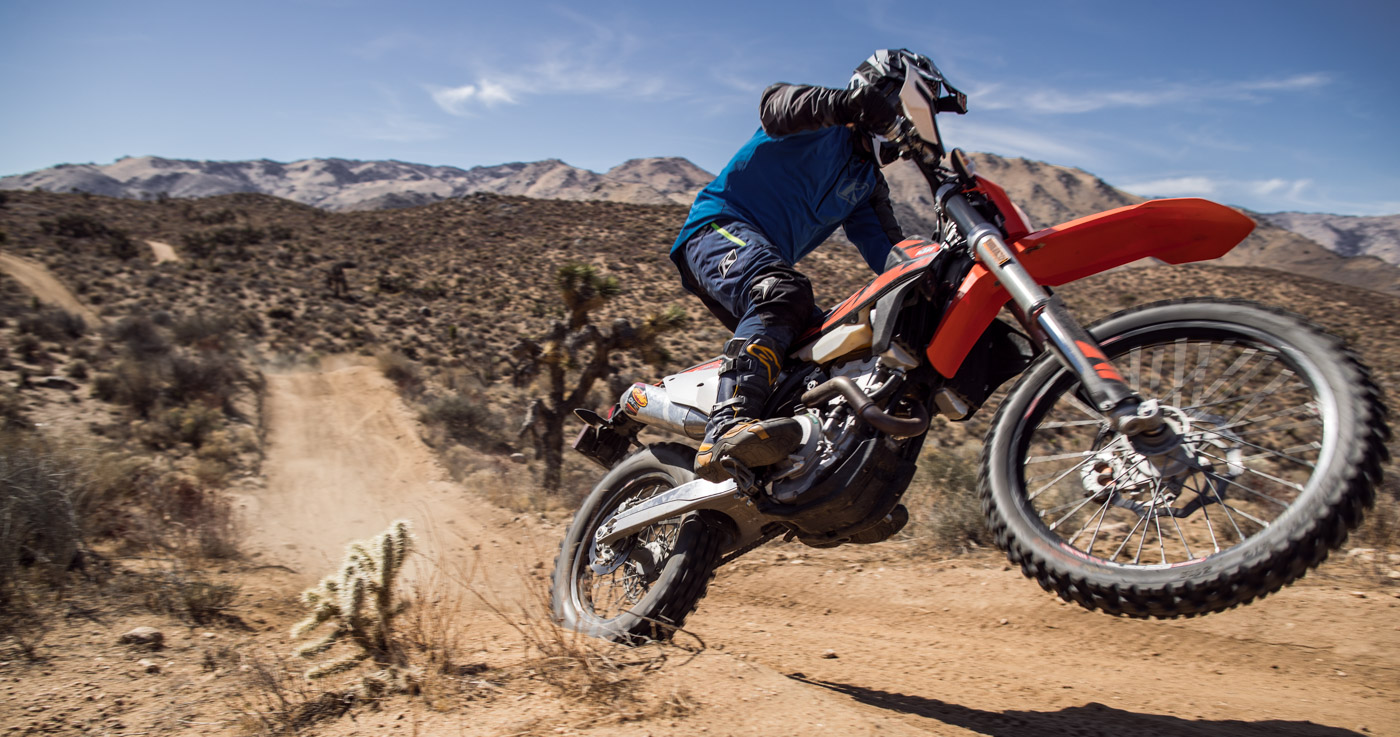
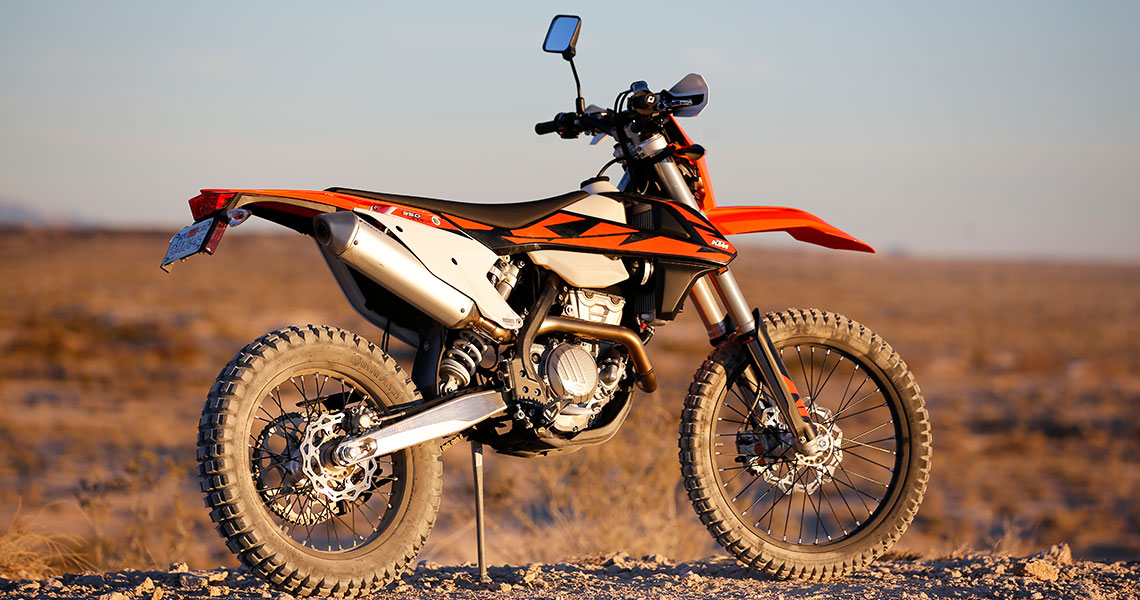
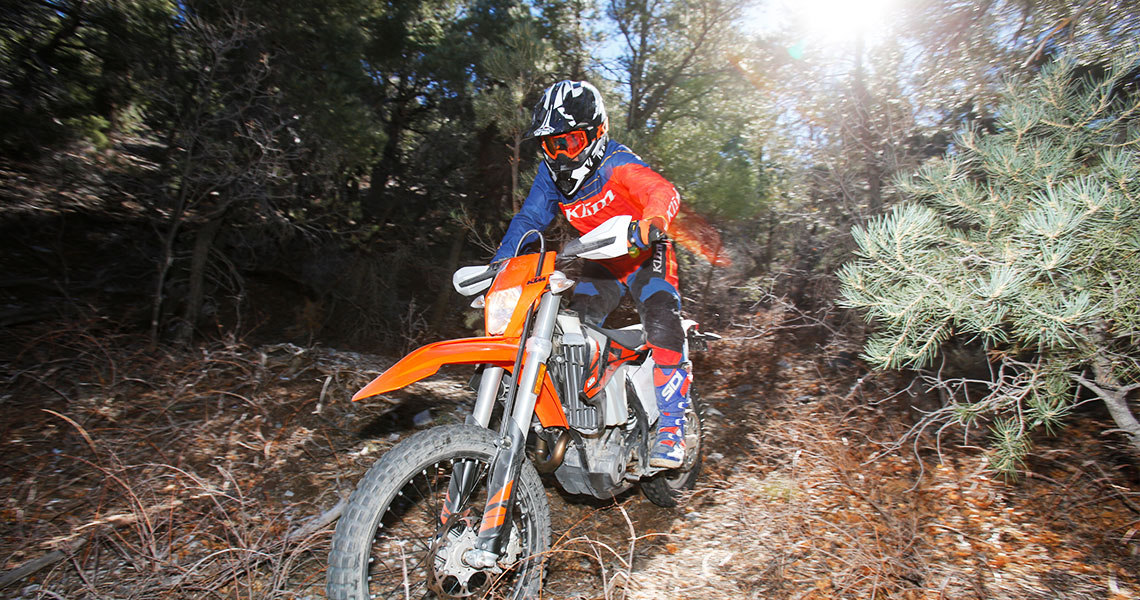
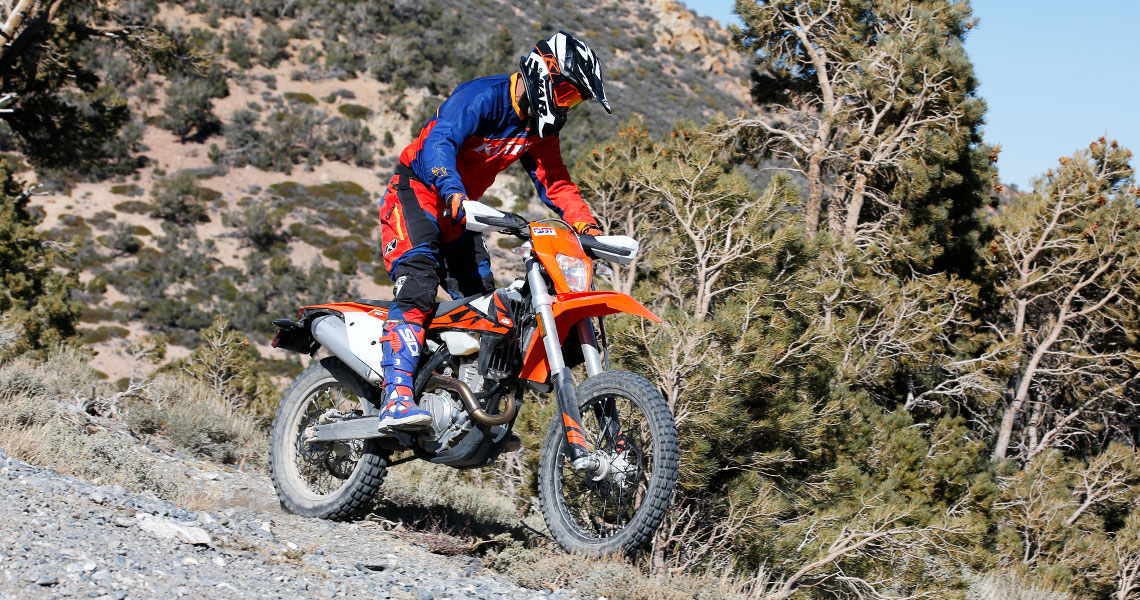

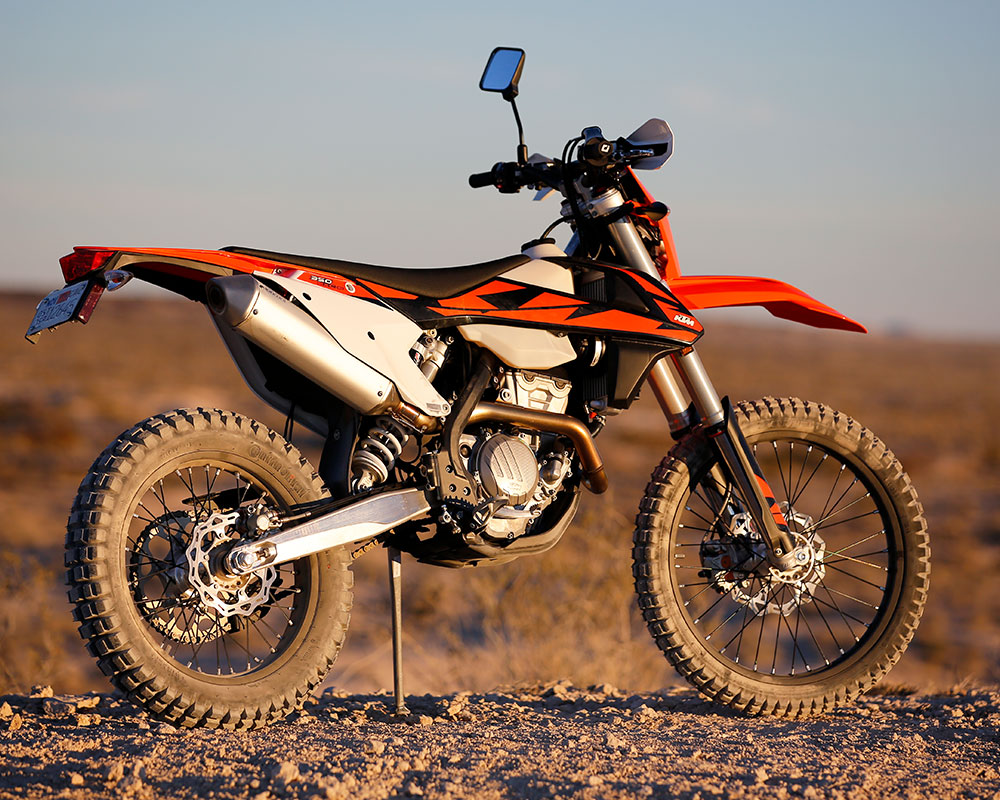
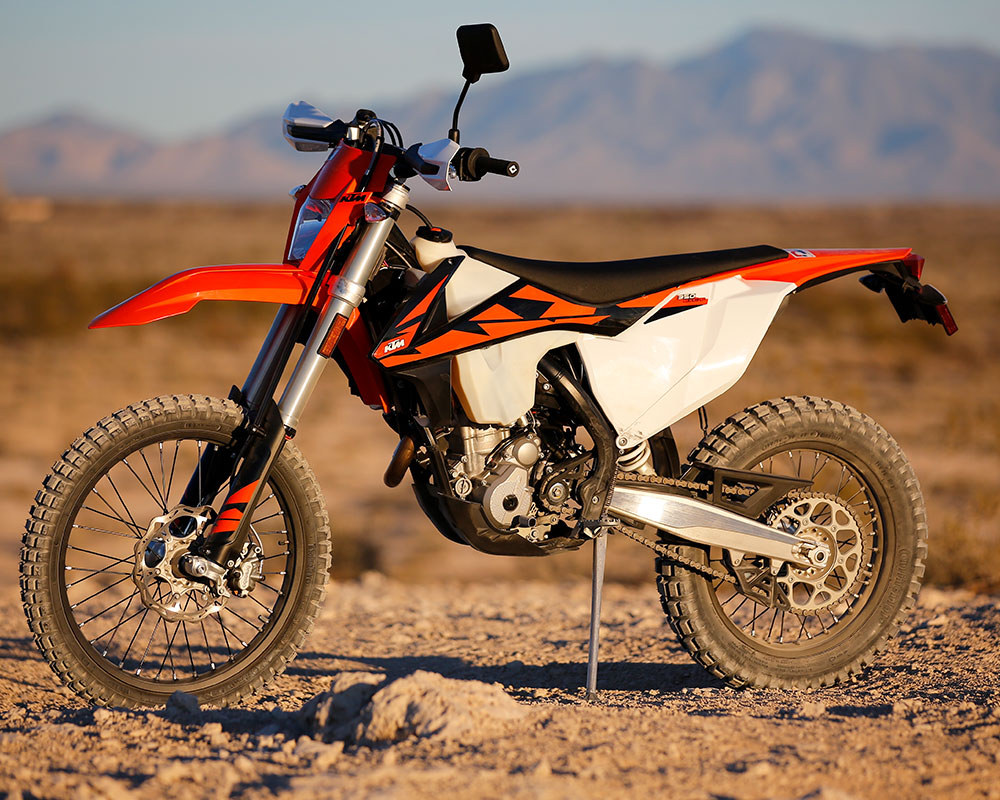
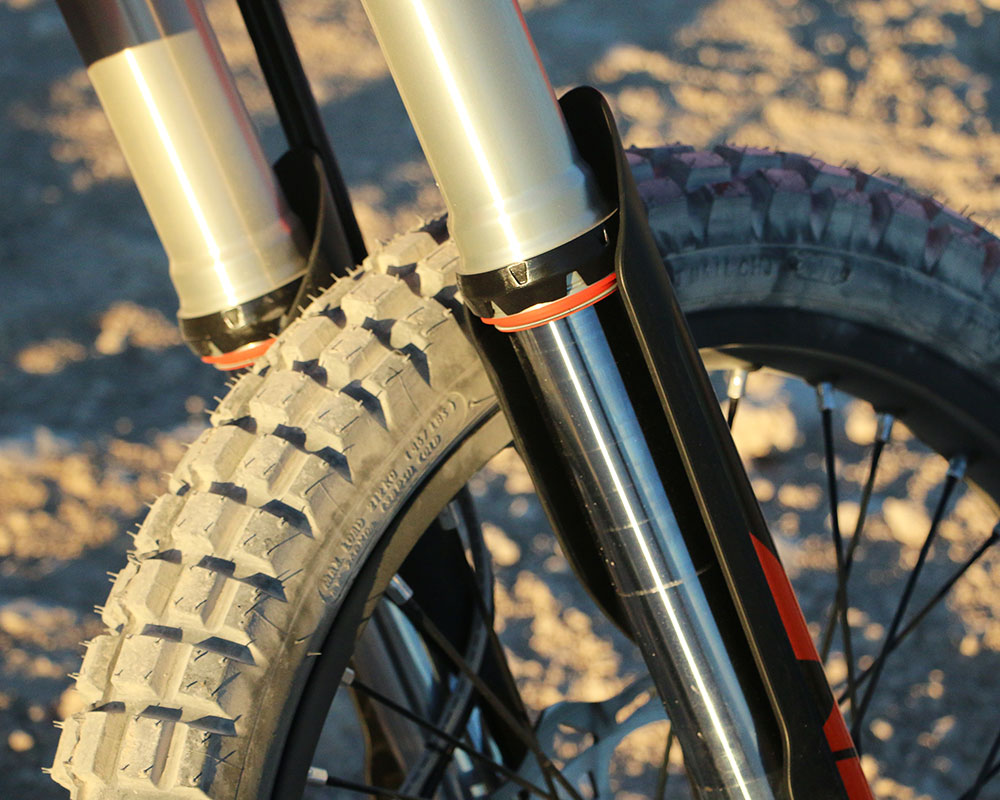
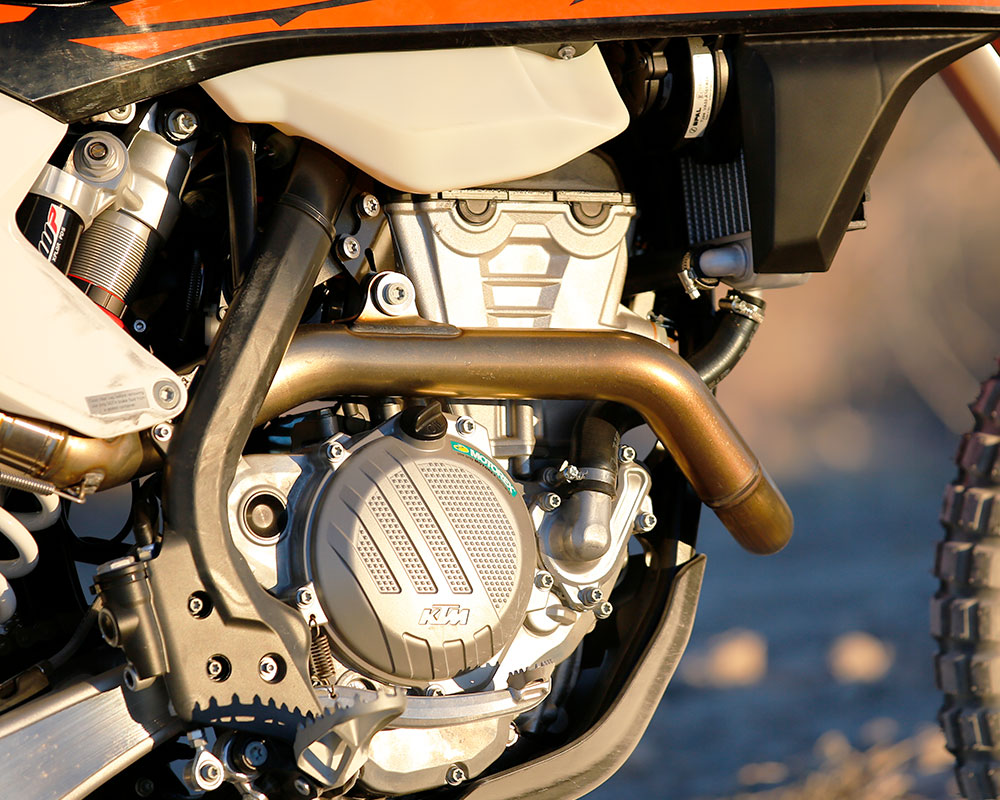

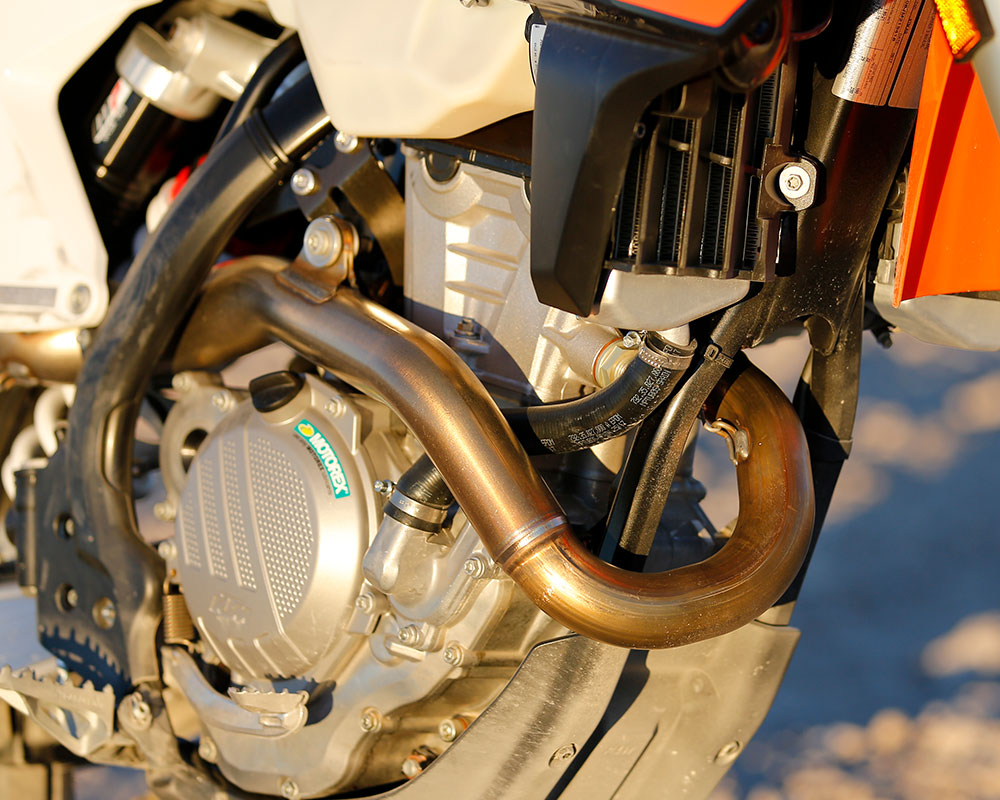
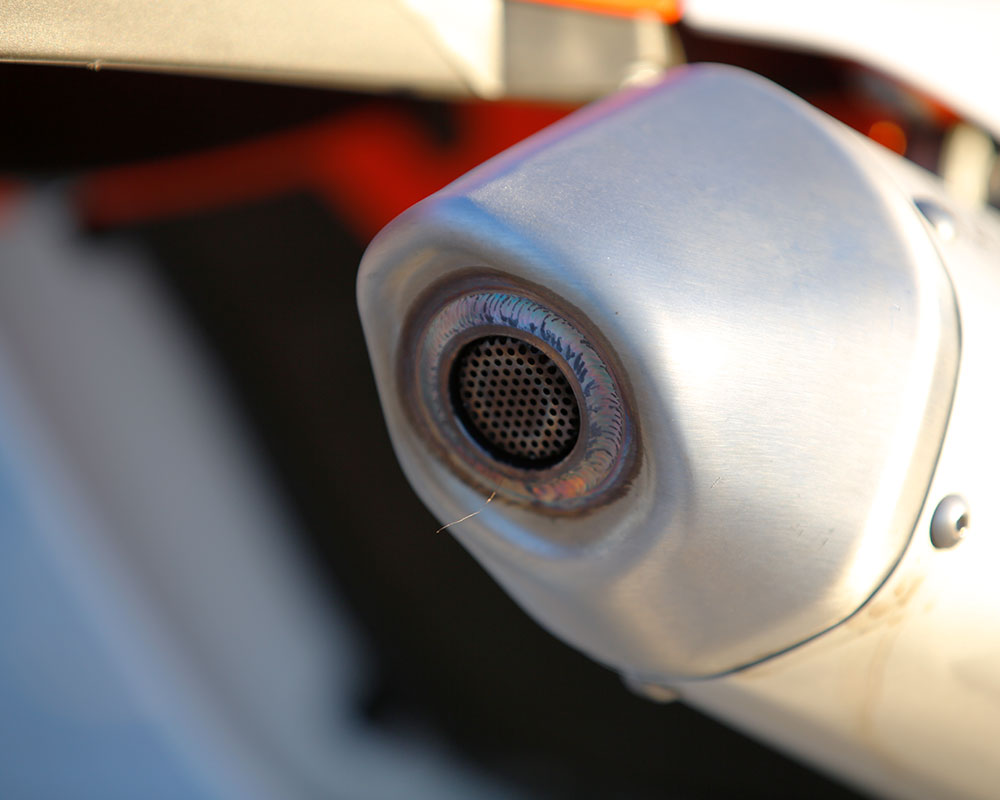
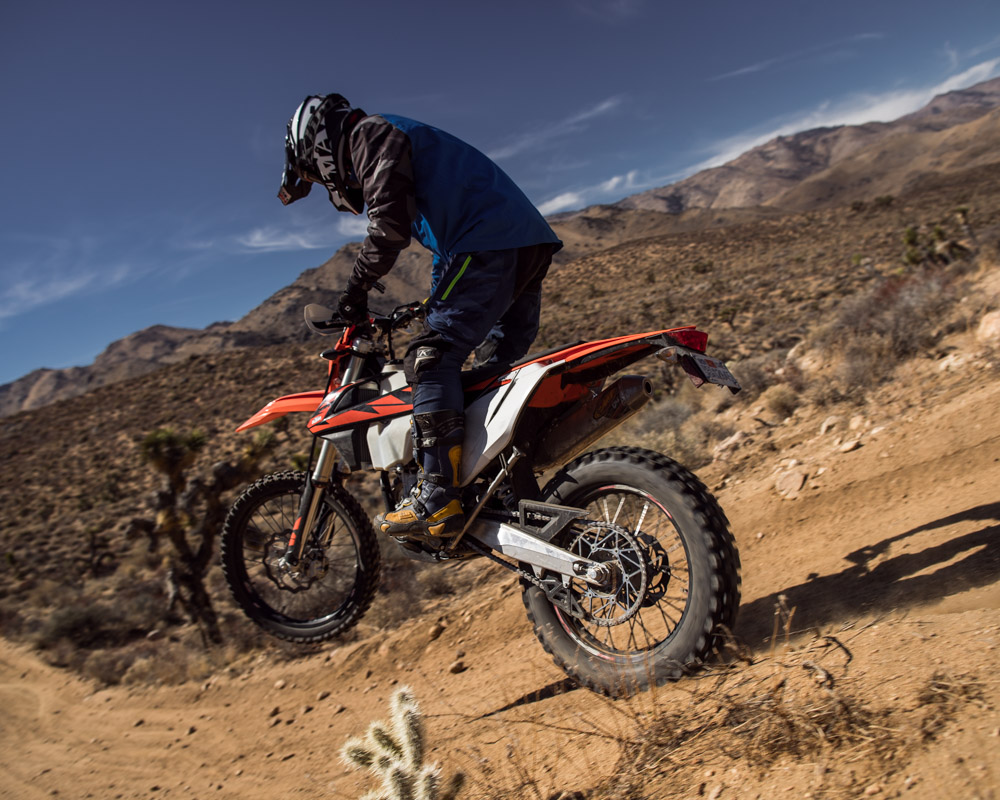

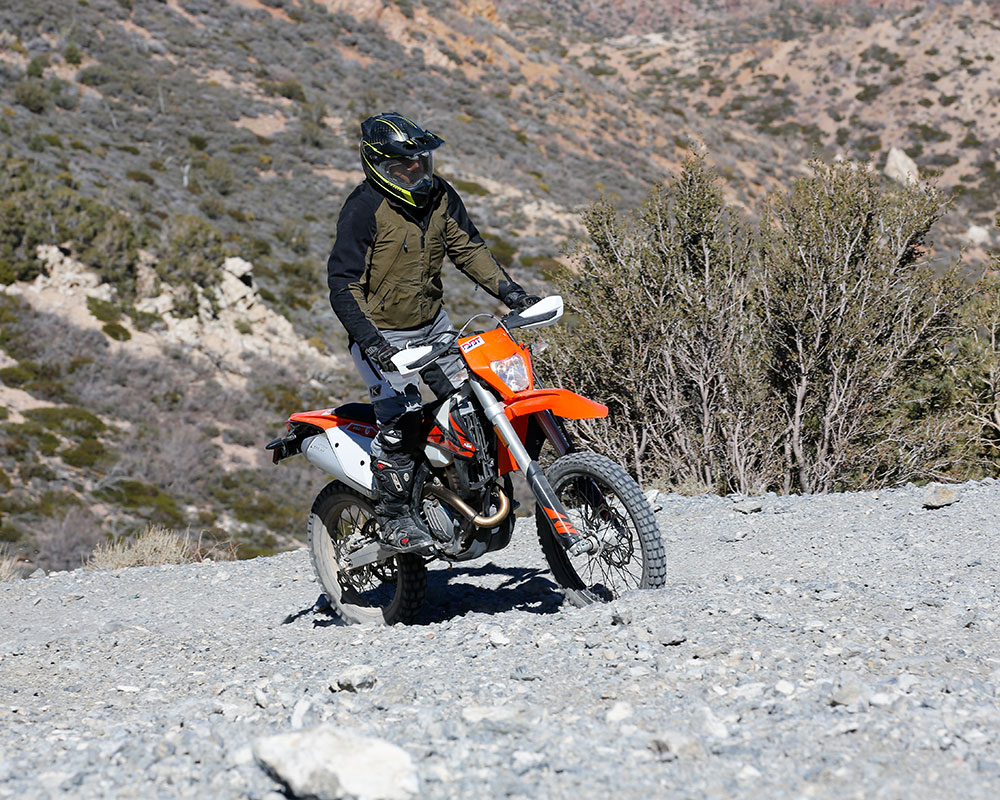
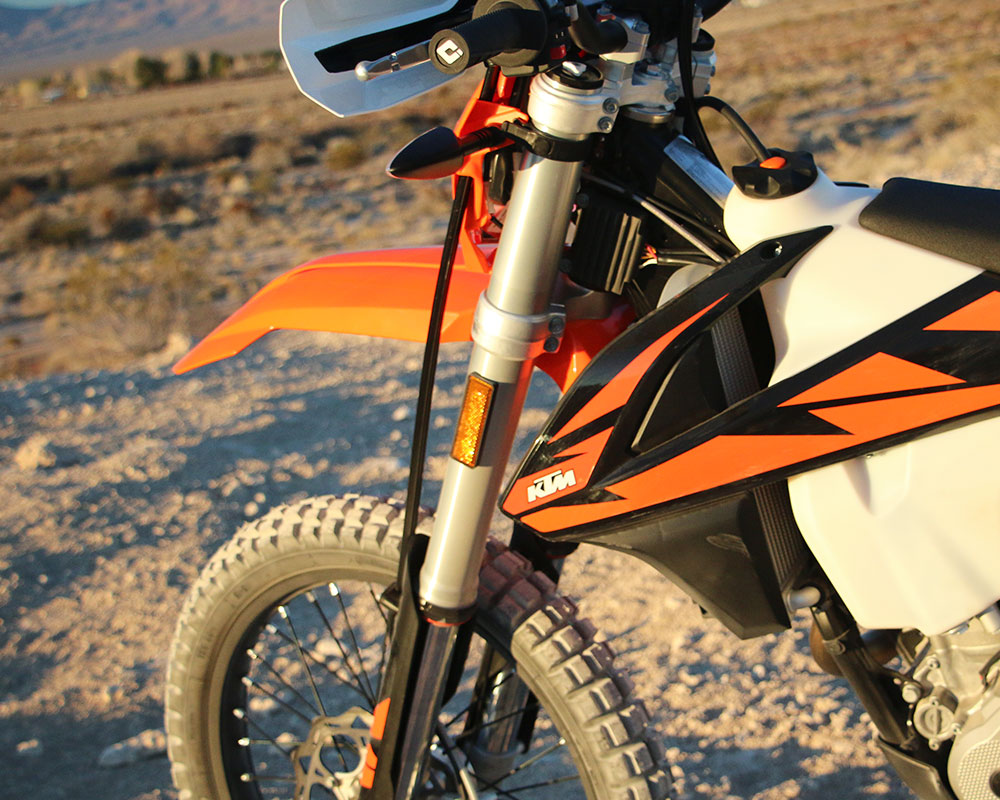
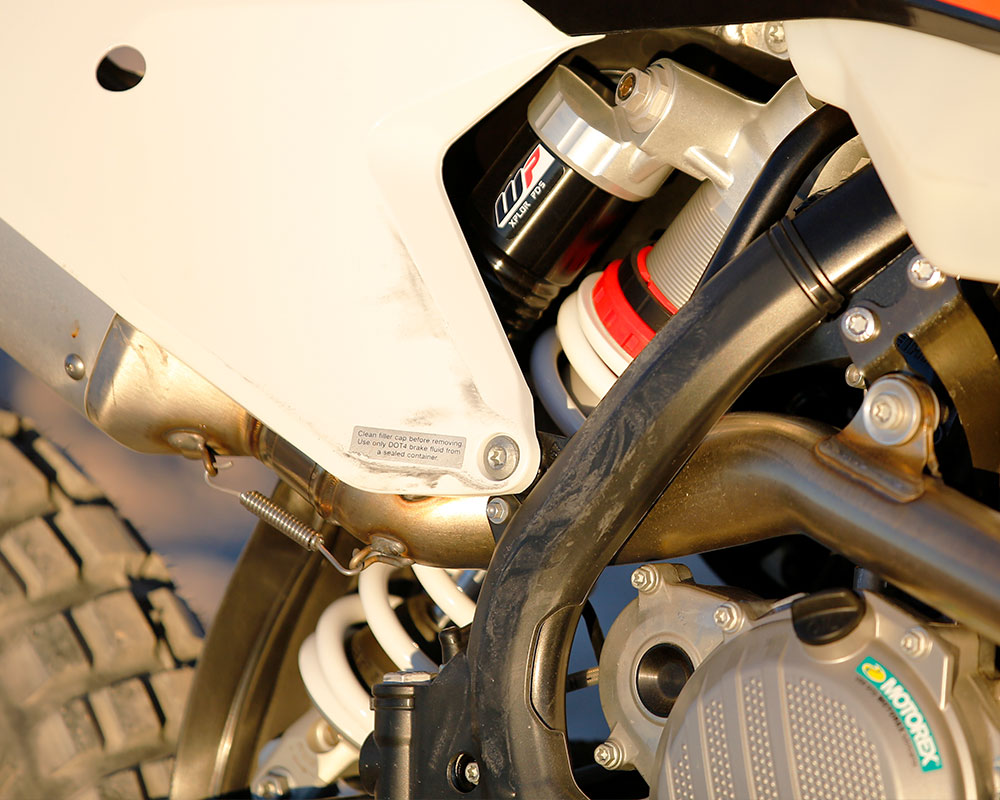
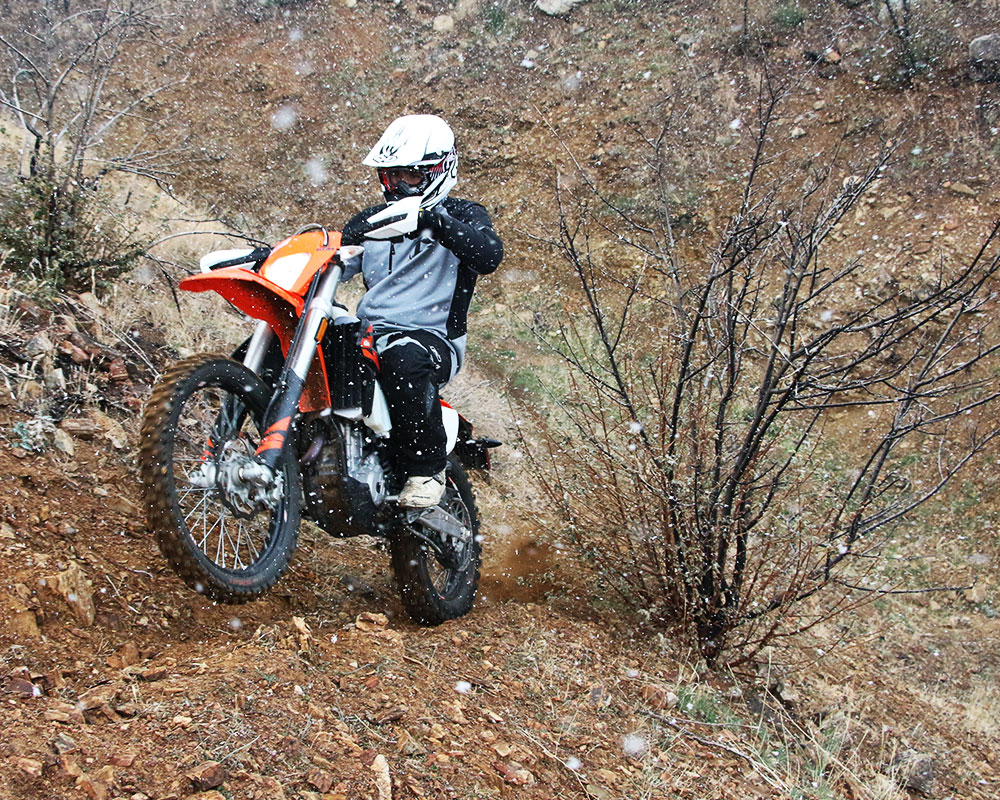
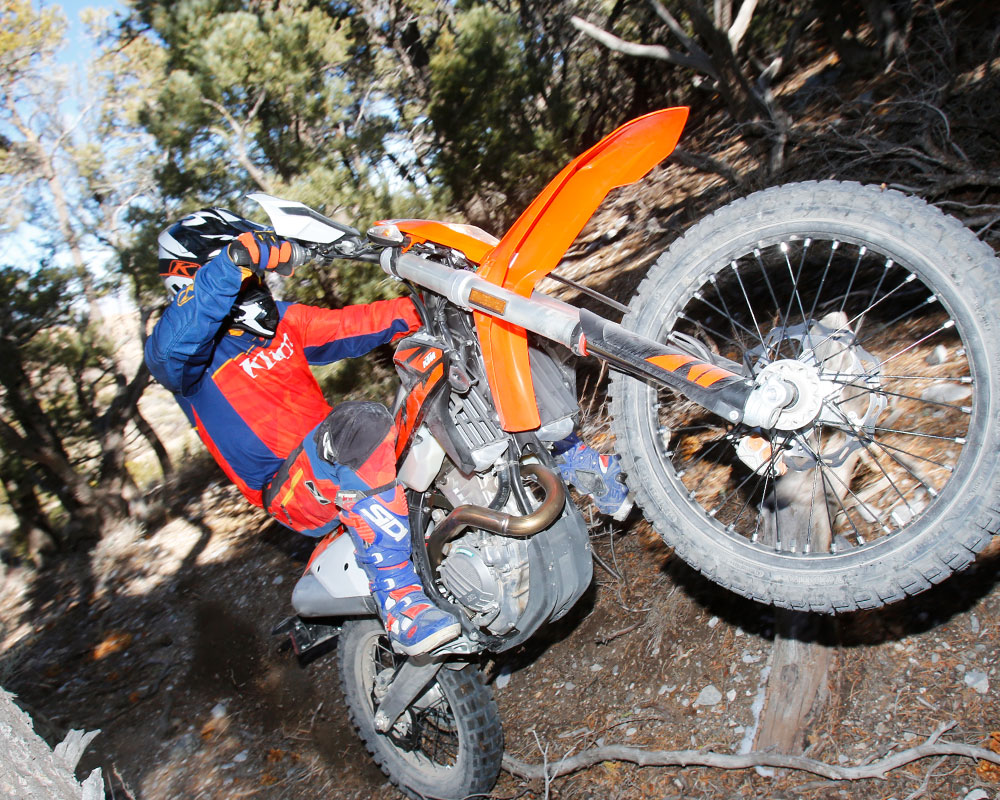


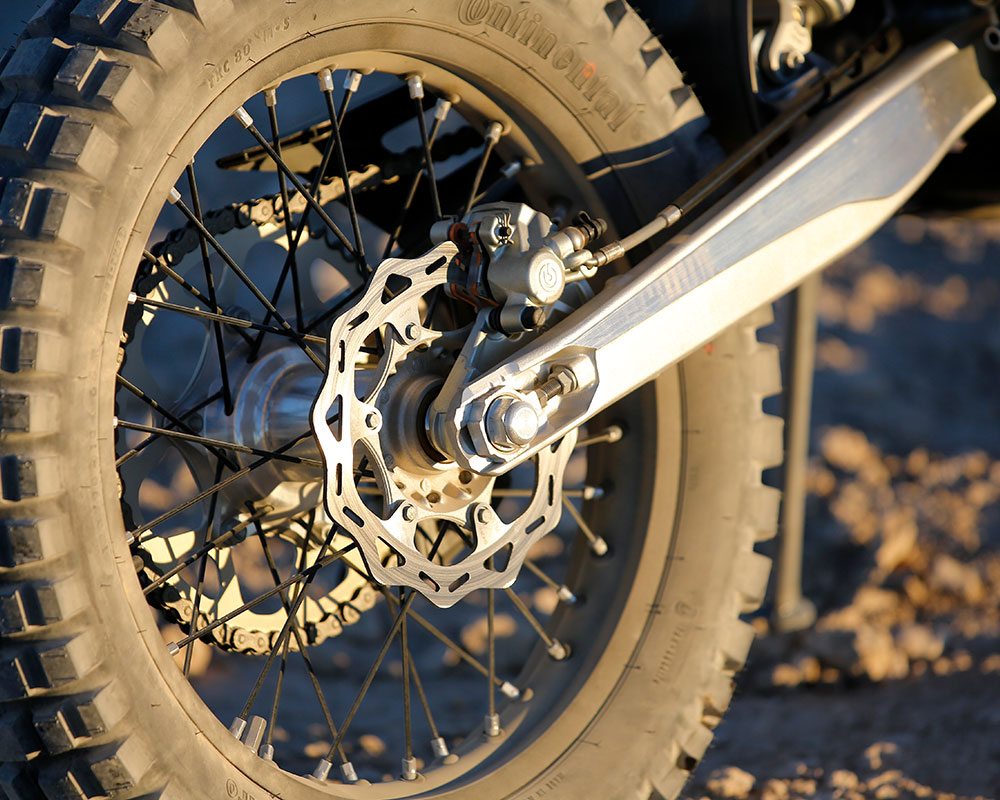


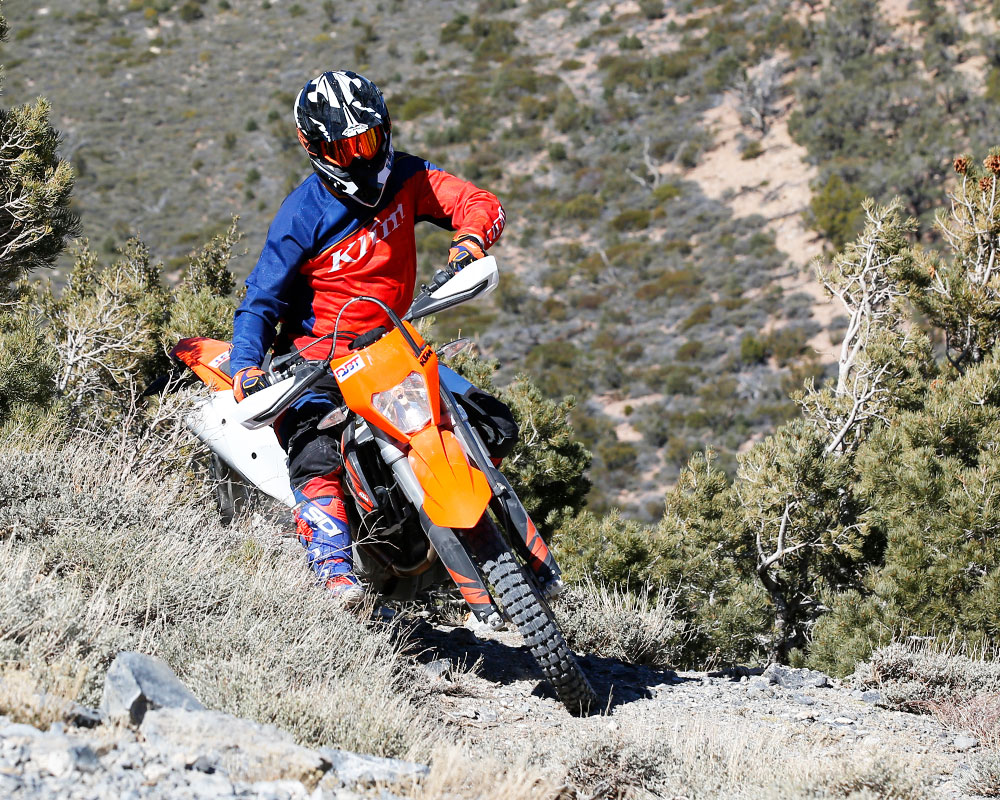
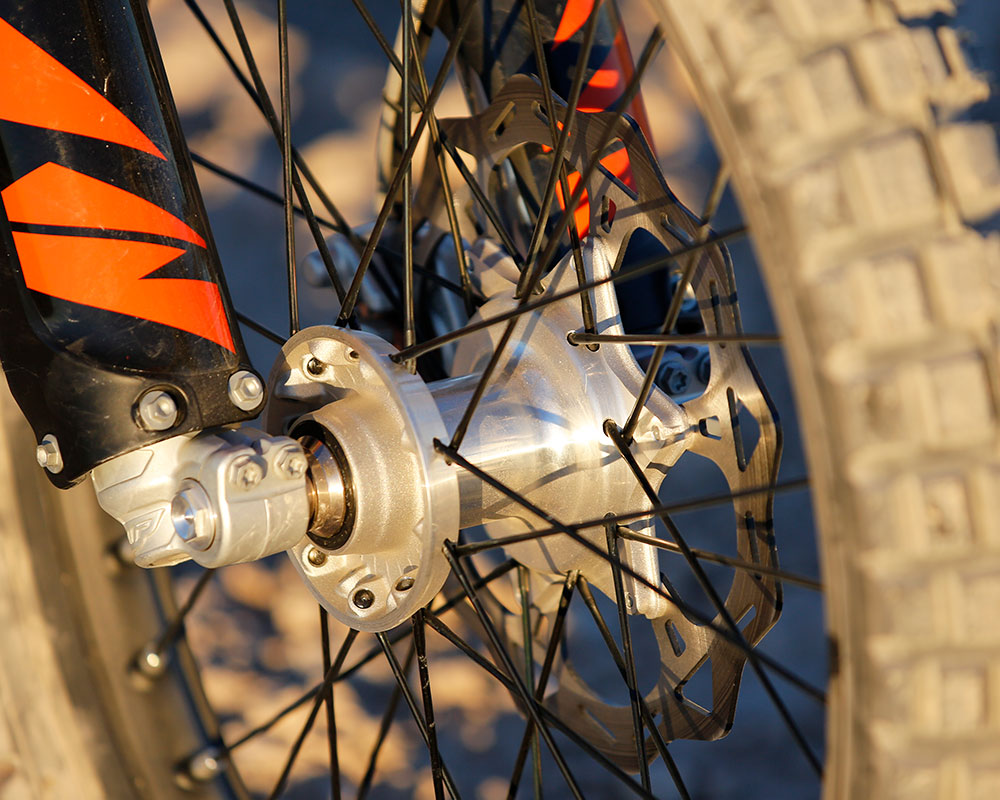

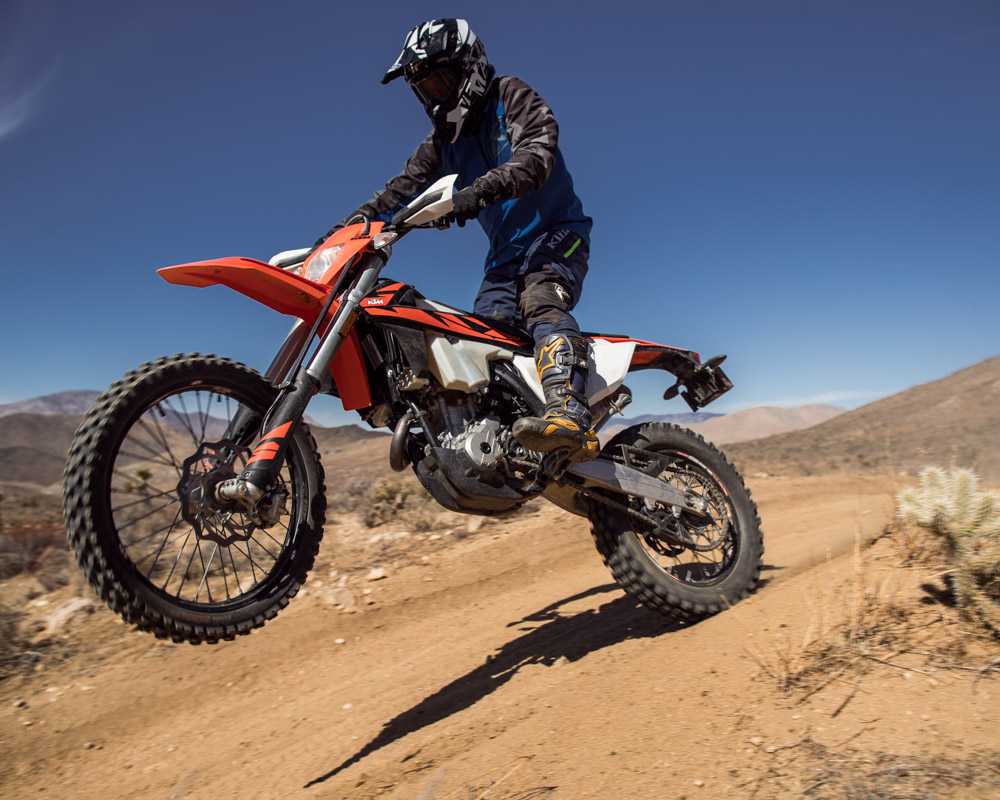
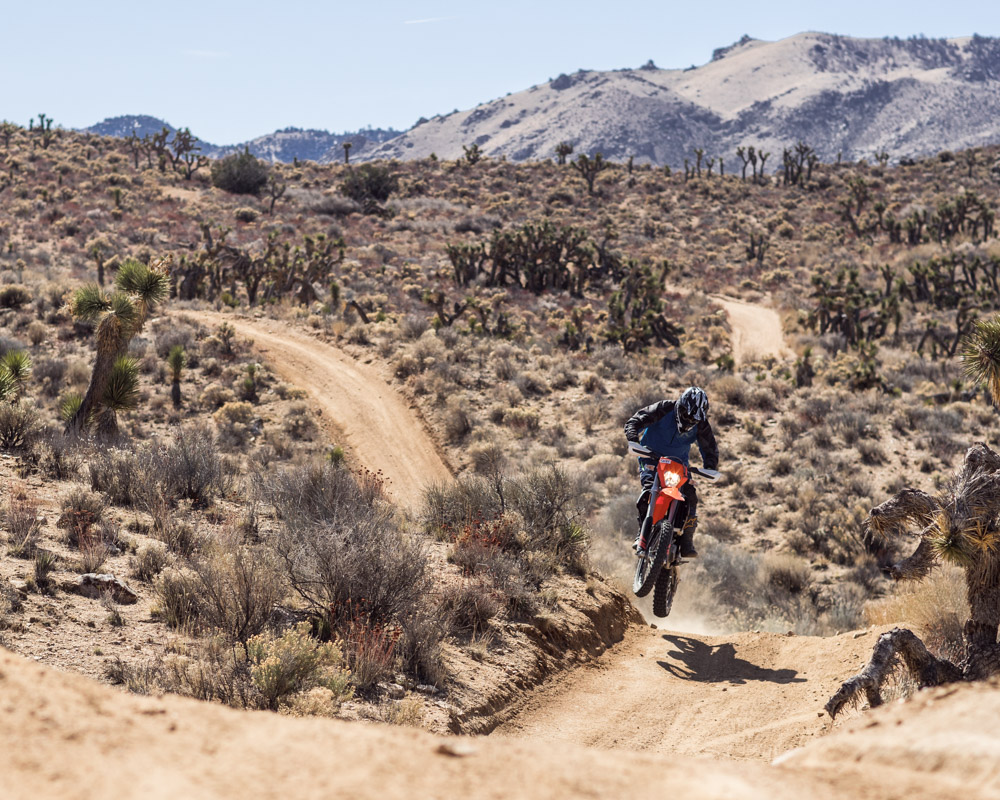
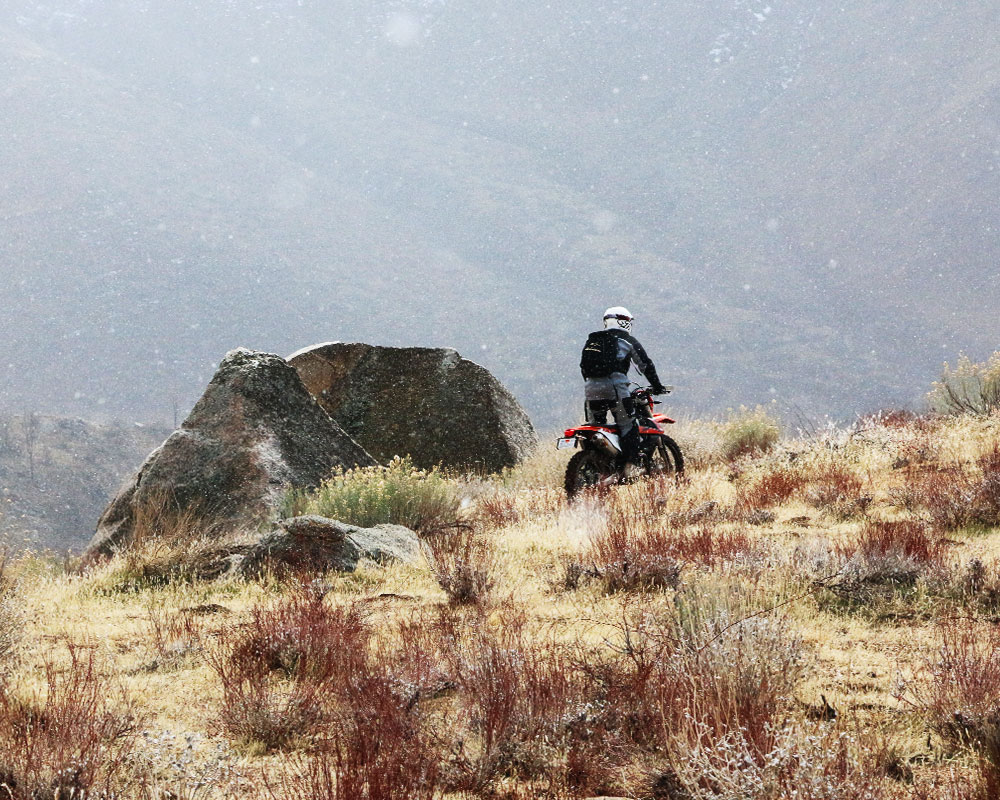

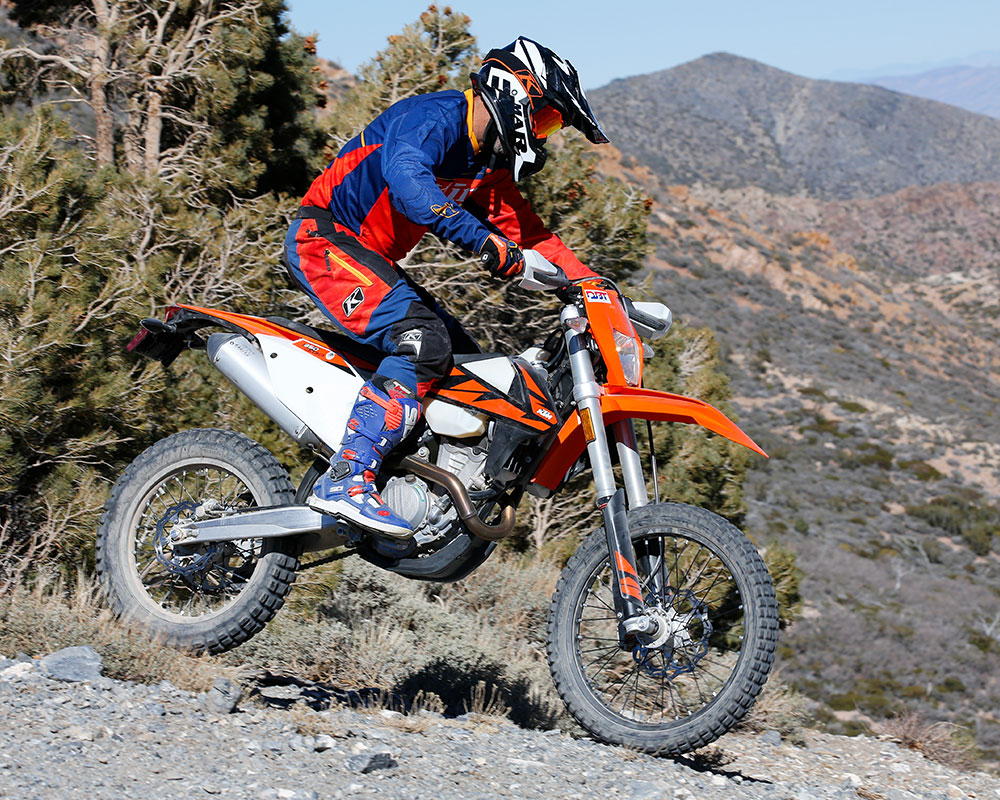
18 Responses to “2018 KTM 350 EXC-F”
Jimmy Lewis
I don’t believe there is a 350 XCW in 2016, just EXC. But EXC to EXC the new motor has more low wnd torque and runs smoother and stronger on the bottom. Since the bottom is so much better the mid range and top end do not feel as impressive but they still have all the beans needed.
Ron
Jimmy how does the 2015 350xcw that you tested compare to this new 350exc engine?
Jimmy Lewis
The new engine has a noticeable amount of increased torque right from idle to mid throttle and it revs a lot more free on top with about the same power. I like the gear spread of the older 350 better and would seriously look into switching wither 1st or 6th ion the new engine if it would be possible.
Jimmy Lewis
The Q4 was run both ways but needed the insert to work with the stock ECU, Yet it was still lean. Not as quiet as standard but not too loud either. We keep the inserts in the Q always as a practice only removing it for testing. Otherwise just get the Powercore.
Jimmy Lewis
I don’t believe a dyno graph is worth many words as that is usually a wide open throttle interpretation of what your power is doing. And who rides at wide open? Who has that much traction off-road?
So most of the comments of others are because they can’t say anything bad and they know very few will ride the bikes totally stock. There is a lot of potential in the motors, we all know this, how you go about modifying them is a subject of great debate depending on who is trying to get inside your wallet and what you really need as a rider.
We always ride the bikes stock and do a full impression of them this way as a “controlled constant.” Once anyone starts to modify from there it gets “personal” and the question becomes, “What are you trying to accomplish?”
The reason the HP numbers went away is that the bikes are limited in HP due to the asinine way the sound test is conducted (which is based on peak horsepower and peak RPM.) So, yes most EPA street legal bikes have limited power to meet sound requirements and those numbers do not look good on sales sheets when there is a lot left on the table. Our are those numbers not even relevant for most riders past the few times they take a full pull on a road sometime?
Realize where you really ride the bike, the throttle positions you use and the RPM range you use the bike. Then wonder about the number a lot of riders make decisions based on. There should be a “rideability” scale of some sort but who would want to look at that?!?
All said and done the EXC can easily be made as aggressive as an SX by a good tuner since the architecture of the engine is basically identical.
Matthew
Actually, I’d love to look at a “rideability index”. My days of hard charging are long over but I still want to get out and go places and have fun. I find the constant pushing of “ready to race” or its equivalent to be tiresome and unhelpful. So if you’d like to make a rideability index I’m all for it. I suspect others would be as well. Actually, though you don’t do an actual index, your honest and broad opinions on bikes and gear and the real-world usefulness of them is why I read visit your site. Balls out performance reviews by young hot shots are a dime a dozen.
Jimmy Lewis
Usually no one. I’m a washed up motorcycle racer who actually slipped through school so I’d have medical insurance. Today I’m ashamed of all the learning I missed out on an really try and improve step-by-step in writing. But we get the point across and we do try and correct mistakes as much as our collective “few guys doing this in our spare time” will allow. The copy editing job currently pays $0 so if you are offering, we are hiring.
Jerry Wynn Sparks
Your writing is fine, the editing process is a tedious task that I work with daily. My documents get ravaged by Phd types everyday and I have 4 college degrees! Great article Sir…
Jimmy Lewis
Thanks, we do OK for motorcycle riders and racers…
Sam Punderson
So, in your opinion Jimmy, is this the ultimate Tour of Idaho bike choice? Or would you still choose to ride a 500?
Jimmy Lewis
It depends on the rider. Rev or torque. More or less weight feel.
Sam Punderson
Torque is king in my book. What do you think the real world (weighed on a scale) weight difference is between the two bikes?
Jimmy Lewis
I have not had the 500 on our scale so I can’t tell you that number. KTM’s figures are very accurate these days (no gas) so you could use those numbers if you’d like.
Jimmy Lewis
Or they trust us on what we say. And we take that very seriously when writing evaluations and testing products.
Jerry Wynn Sparks
Grammatical errors is what you take away from that? What are you an asshole?
Scot Zundel
“better tune the fuel mixture as well”. How do you recommend doing that? Thanks
Jimmy Lewis
The easiest way is with a JD Jetting Power Surge tool.
Jimmy Lewis
Ryan,
Please reach out to Jimmy@dirtbiketest.com